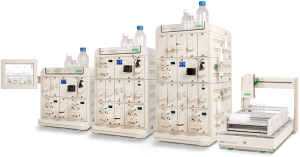Carter Mitchell, PhD, is a protein problem solver. As Chief Science Officer at Kemp Proteins, he helps academic and industry researchers develop a range of protein therapeutics, diagnostics, and molecular tools, such as antibodies, virus-like particles nanoparticles, antigens, and enzymes, in milligram to gram quantities with bioprocess scale in mind.
Using advanced instrumentation, such as the NGC Chromatography System, Mitchell employs creative approaches for purification of challenging protein targets whose biophysical parameters make them less amenable for expression, purification, and scaling. In this interview, we discussed how Kemp Proteins ensures delivery of high-quality processes and protein-based products to their clients, even when working with difficult proteins.

Carter Mitchell, PhD, Chief Science Officer, Kemp Proteins
Q: What does your protein production workflow look like?
A: Our general workflow begins with a client request for either purification of conditioned media, cell paste, or extract containing the protein target, or, as in ~75% of our programs, Gene-to-Protein. The latter case, clients will provide a UNIPROT number, amino acid sequence or nucleic acid sequence, which we use to design expression constructs in silico, synthesize the gene(s) of interest, and clone into expression vectors suitable for the client needs. Upon receipt of the expression constructs, we test various expression systems, such as HEK293, CHO, Hi5, Sf9/21, and/or bacterial cell lines including Escherichia coli, Mycobacterium smegmatis, or Bacillus subtilis. We plan to work with Pichia within the next few years. In the end, we assess different expression systems to identify the preferred mode to generate large quantities of protein with the critical quality attributes desired.
We first qualify various protein expression modalities with standard SDS-PAGE and western blotting methods. Often, we perform automated microscale purification with a liquid handler system using off-the-shelf or custom chromatographic resins packed into tips. With the microscale system, we generate enough material for bio-layer interferometry (BLI) to [determine] titer and affinity. At this point we can use the microscale purified material to assess protein stability with differential scanning fluorimetry (DSF). Using these data, preferred constructs and expression modalities are identified and transitioned into pilot scale expression for optimization to increase yield. The pilot scale is where we enter the process discovery phase to identify robust processes for expression/purification and removal of viral contaminants, host cell protein, and host cell DNA. At each step, we maintain the quality necessary for product development.
Q: What are the common challenges you face during protein production?
A: When a client requests a particular protein, the sequence is submitted to a bioinformatics pipeline to learn about its biophysical properties and predict any problems we might encounter. Before we express the protein, we run in silico analyses to address the following questions: How stable is the protein? Is it secreted natively or cytosolic targeting? Does it have post-translational modifications? Is it a pre-protein that must be cleaved? The bioinformatics can also predict if the protein is going to be insoluble in the production steps.
Q: How long does it take to produce large quantities of protein?
A: Scaling up creates a bottleneck and affects the time required to converge on the final process. As the protein concentration increases, the volume needed to separate the protein increases. Chromatographic resins are the gold standard for protein separation, but they can require long run times and/or become cost prohibitively expensive for the scaled process. For example, purifying four grams of protein in a standard 26/60 size exclusion chromatography (SEC) column can take 40 hours over multiple injections. There are SEC columns that tolerate faster separation with minimal loss in resolution, and we have great success with the Bio-Rad SEC columns in development. These columns decrease the total processing time from four hours to 45-60 minutes per injection, while also tolerating NaOH without destroying the resin matrix. After process discovery and development, the actual time-to-process large scale usually takes about 3-10 days including the in-process controls with final QC [quality control] and batch record review taking an additional 2 weeks depending on release criteria.
Q: How do you optimize the purification of tricky proteins?

The modular design of NGC Chromatography Systems makes it easy to optimize protocols and switch configurations for different purification needs.
A: We incorporate several risk mitigation steps when working with difficult proteins, such as insoluble or “sticky” proteins. For example, we may add fusion tags to increase their solubility or an unstructured handle to accommodate refolding efforts. Generally speaking, we follow standard protein refolding workflows: isolate and wash inclusion bodies, solubilize and refold with reducing pairs prior to purification. Occasionally, a client’s program relies on the recombinant protein and is required to move forward with their work regardless of solubility issues. We have successfully used chromatography-based refolding, such as affinity columns or size exclusion columns charged with urea or guanidine, in addition to bucket refolding, dialysis, and/or TFF [tangential flow filtration] for removal of chaotrope and reducing agent. For instance, various SARS-CoV-2 proteins were insoluble, but we successfully and reproducibly refolded the targets, which were highly immunologic when injected into animals. In a nutshell, the downstream processes need to consider the scale and program requirements to increase the likelihood of success. The expression modes, construct designs, sample handling, and downstream process parameters have a profound effect on success of a given program.
Learn more about simplifying protein purification with the NGC System.

